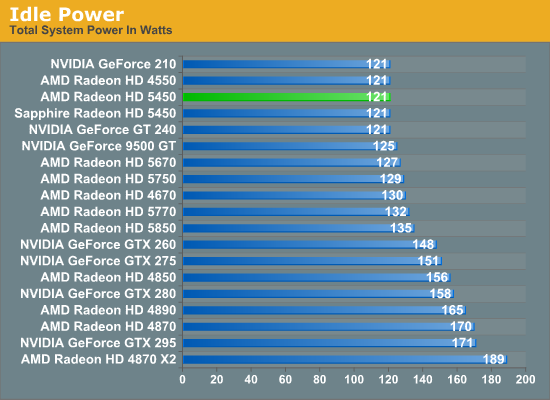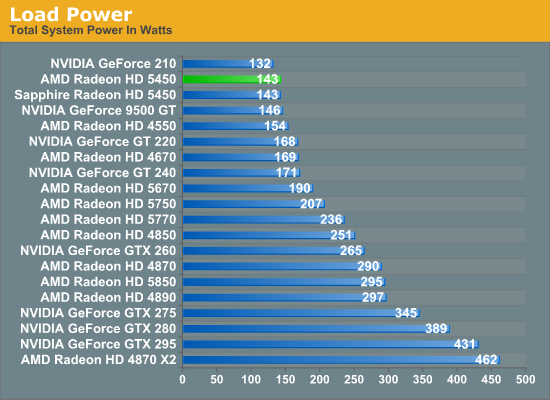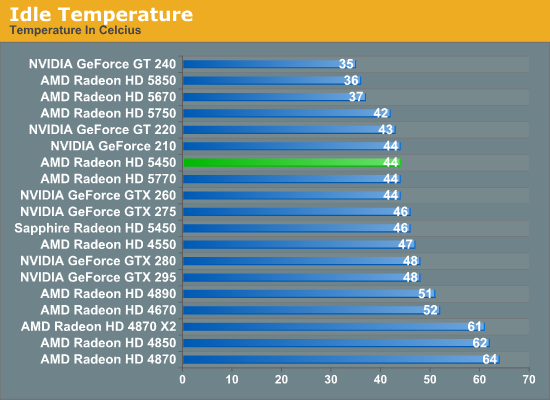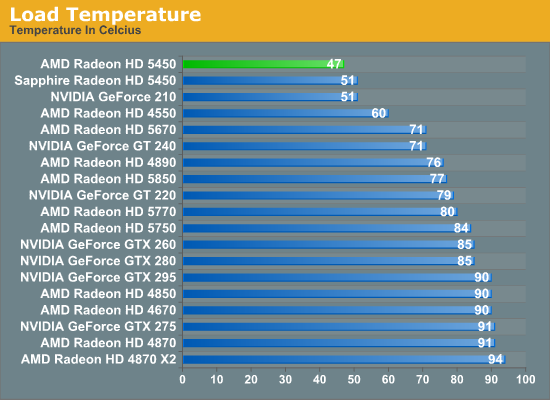AMD’s Radeon HD 5450: The Next Step In HTPC Video Cards
by Ryan Smith on February 4, 2010 12:00 AM EST- Posted in
- GPUs
Power & Temperatures
While entry-level video cards may not top the performance charts, their low transistor count and low power usage means that they do very well on our power and temperature charts. And by being passively cooled, they are winners by default for noise, as they don’t generate any noise to measure.


On paper these cards differ by around a few watts when it comes to idle power, but by the time you put them in our i7 test rig, those few watts melt away. The Radeon 5450, the Radeon 4550, and the GeForce 210 all idle at 121W on our test rig, tying with the GeForce GT 240 for the lowest idle power usage we’ve measured.
Under load this changes some. The 5450 offers the second-lowest load power usage that we’ve measured, coming in below things like the GT 220 and the 4550. It doesn’t quite best the GeForce 210 however, which we believe to be a combination of the 210’s smaller-yet GPU and differences to how NVIDIA and AMD go about throttling their cards when we’re running FurMark.
At any rate, the 5450 does particularly well against other AMD cards, not only beating the 4000-series, but coming in under the 5670 by a hefty 47W. The 5670 may be the better HTPC card from a deinterlacing standpoint right now, but you pay for it with power.


We should note that for our load temperature testing, we use a closed case with all of the fans active on our Thermaltake Spedo case. So the results here are from plenty of airflow being sent towards the first PCIe x16 slot. Since we’re looking at passive cards today, they’re much more affected by this than actively cooled cards are. In a case with little to no airflow, these passive cards would definitely get hotter.
For load temperatures, the 5450 is the coolest video card we have ever tested, taking the title by 4C over its nearest competitor, the GeForce 210. This is thanks in a large part to the use of a double-wide heatsink for better heat dissipation, and of course the low power consumption of the 5450 in the first place. This also gives us a chance to quantify the differences between the double-wide heatsink on the reference card and the single-wide heatsink on the Sapphire 5450; the smaller Sapphire heatsink is only 4C worse at 51C. The double-wide heatsink in this case looks to be overkill.
At idle things change some. Our coolest cards are the actively cooled cards, which have their own fans to keep them cool. The passively cooled cards on the other hand build up some additional heat, coming in at the mid-40s, similar to several of our mid-range cards.










77 Comments
View All Comments
Ryan Smith - Thursday, February 4, 2010 - link
That is one of the things that changed. However it's not very resource intensive for the shaders (which is one of the reasons why it was moved in the first place) and I don't seriously suspect that's the cause.andy o - Thursday, February 4, 2010 - link
So far all the 5000 series cards have an issue with PowerPlay. It messes audio especially on Dolby digital and DTS tracks, when DXVA is disabled. When DXVA is enabled the clocks are stabilized (at 400 MHz GPU and 900 MHz memory for the 5770), so Powerplay doesn't screw with the audio. Without using DXVA, the clocks are all over the place (PowerPlay enabled, normally a good thing), and this gives audio dropouts with DD and DTS tracks.Could you test this, with HD videos and DD/DTS tracks? Maybe you'll have a better chance of getting this fixed than a bunch of us just dealing with their horrible support.
Powerplay also triggers funky sound when HDMI is used and 5.1 or 7.1 24-bit 96 kHz or 192 kHz output is set on Windows. Just set it like that and go about your business and you'll hear either crackling or crazy channel switching.
See here for reference, and the following posts of other users who confirm it, and even come up with their own ways to disable Powerplay. This thread at Doom9 was where it was discovered, and later confirmed by nearly everyone who tried (except one strange case or two).
Ryan Smith - Saturday, February 6, 2010 - link
Andy, shoot me an email. I was going to email you, but I'm not sure the address for you in our system actually goes to an account that gets read.andy o - Monday, February 8, 2010 - link
just sent you the email, thanks.PR3ACH3R - Friday, February 5, 2010 - link
[Quote]So far all the 5000 series cards have an issue with PowerPlay. It messes audio especially on Dolby digital and DTS tracks, when DXVA is disabled. When DXVA is enabled the clocks are stabilized (at 400 MHz GPU and 900 MHz memory for the 5770), so Powerplay doesn't screw with the audio. Without using DXVA, the clocks are all over the place (PowerPlay enabled, normally a good thing), and this gives audio dropouts with DD and DTS tracks.
[/quote]
1. ATI & the Review Sites, including Anandtech,
have been ignoring this horrible problem in these cards,
which makes them , for all practical purposes - useless.
But - It does not stop there.
2. The problem you have mentioned with The 57xx series,
creates SERIOUS DPC latencies , especially in XP,
that brakes even the fastest systems, & All audio is full of glitches & clicks chaos.
3. To add insult to injury 2D performance is the worst EVER seen on the PC, beaten even By IGPs.
Bottom Line:
Anadtech yet again fails to detect & report to these issues,
So I would not expect any replies to your questions here.
These cards spell Recall / Class Action all over them.
andyo - Friday, February 5, 2010 - link
Also, I'm not sure what you mean with number 3 (2D performance issues). Could you give some examples so I can test it?PR3ACH3R - Saturday, February 6, 2010 - link
If You do any sort of regular graphics (ignore the IF..)its all 2D ..
After looking hopelessly for ANY solution or even recognition to this problem from professionals, so I can share it, I found there is only one Site with staff professional & unbiased enough to Note the problem.
Not only did they notice it, they published 2 giant articles about it, & it is painfully, obviously, certainly NOT Anandtech.
http://translate.googleusercontent.com/translate_c...">http://translate.googleusercontent.com/...usg=ALkJ...
http://translate.googleusercontent.com/translate_c...">http://translate.googleusercontent.com/...usg=ALkJ...
andyo - Friday, February 5, 2010 - link
It is a big issue, but I'm not sure if it's a hardware problem. It's probably a driver thing.In any case, you can disable Powerplay for the time being, I've done what I linked above and it's working acceptably for me, when I play a game, I'll switch profiles to enable the higher clocks. I'm not sure how it would work on XP though or if the procedure is the same, but you can also use GPU clock tool to stabilize the clocks.
Taft12 - Thursday, February 4, 2010 - link
I have a hard time seeing AMD giving this much attention, the number of users concerned with this issue is infintesimal.Why overclock your GPU when you are focused on the audiophile features? I'll be shocked if the official response is anything other than "Graphics card audio output not supported when Powerplay enabled".
andy o - Thursday, February 4, 2010 - link
Oh and BTW, also as the poster above said, it's not an "audiophile" issue. I actually try to distance myself form that term as much as possible. It's happening whenever DXVA is not enabled, and with DD and DTS audio. As in when playing DVDs with (say) PowerDVD with its post-processing features. Pretty normal scenarios. And it's not a subtle thing. It's dropouts (pops or cut outs in the audio). Also, choppy flash video (shouldn't happen with DXVA accelerated video with flash 10.1 though).Powerplay also triggers horrible crackling and channel switching when output is set to multichannel (5.1 or 7.1) 96 kHz or 192 kHz audio for the Windows mixer. Hardly audiophile issues at all, any of these.